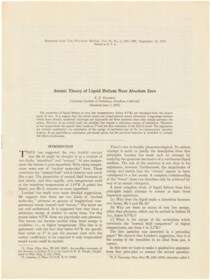ID 370017
Лот 28 | Superfluidity: one of the defining moments in modern physics
Оценочная стоимость
£ 2 000 – 3 000
Atomic theory of liquid helium near absolute zero. [Offprint from Physical Review, v. 91, n. 6. Lancaster, PA and New York, NY: American Institute of Physics, 1953].
Quarto (266 x 200mm). Original wrappers, stapled as issued (punch holes in inner margin filled, not affecting text).
First edition, extremely rare offprint. The discovery of superfluidity of liquid helium is one of the defining moments in modern physics. In this momentous paper Feynman set out a quantum mechanical explanation of the superfluidity of liquid helium at temperatures below the ‘lambda-point’ of 2.18K. Whilst the phenomenon had been observed and theorized upon since 1938, its account lacked an atomistic foundation. “A significant part of Feynman’s central contribution was the demonstration that these phenomenological concepts arose directly from the fundamental quantum mechanics of interacting bosonic atoms with strong repulsive cores. One of his earliest helium papers showed in detail how the symmetric character of the many-body wave function severely restricts the allowed class of low-lying excited states’ (Selected Papers of Richard Feynman, 2000, p.313). Feynman shared the Nobel Prize in Physics 1965 with Sin-Itiro Tomonaga and Julian Schwinger ‘for their fundamental work in quantum electrodynamics, with deep-ploughing consequences for the physics of elementary particles’.
‘The most spectacular signature of the transition of liquid 4He into the superfluid phase is the sudden onset of the ability to flow without apparent friction through capillaries so small that any ordinary liquid (including 4He itself above the lambda transition) would be clamped by its viscosity ... Related phenomena observed in the superfluid phase include the ability to sustain persistent currents in a ring-shaped container; the phenomenon of film creep, … and a thermal conductivity that is millions of times its value in the normal phase and greater than that of the best metallic conductors. Another property is less spectacular but is extremely significant for an understanding of the superfluid phase: if the liquid is cooled through the lambda transition in a bucket that is slowly rotating, then, as the temperature decreases toward absolute zero, the liquid appears gradually to come to rest with respect to the laboratory even though the bucket continues to rotate. This non-rotation effect is completely reversible; the apparent velocity of rotation depends only on the temperature and not on the history of the system’ (Britannica). No copies appear in auction records, or on OCLC.
| Адрес торгов |
CHRISTIE'S 8 King Street, St. James's SW1Y 6QT London Великобритания | |
|---|---|---|
| Предосмотр |
| |
| Телефон | +44 (0)20 7839 9060 | |
| Комиссия | see on Website | |
| Условия использования | Условия использования |



